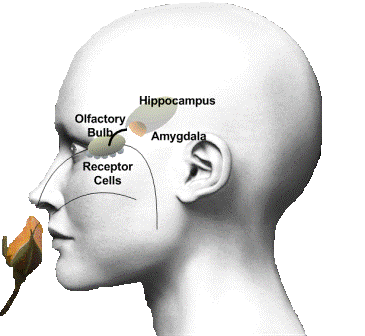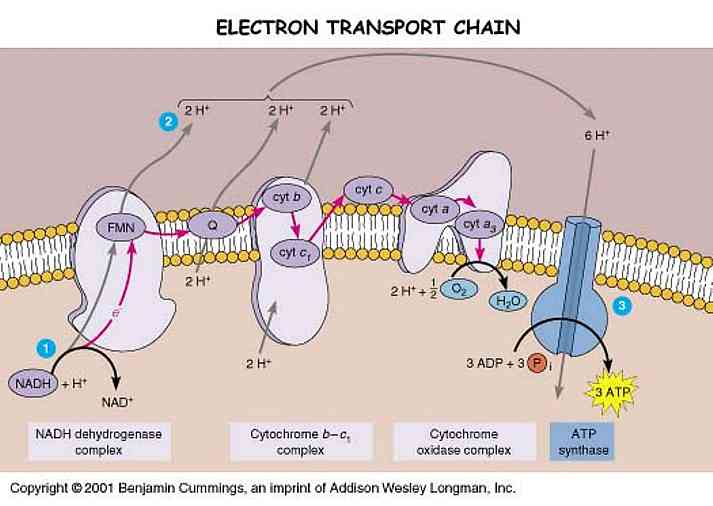킁킁킁..

코의 겉모양은 뭉툭하지만 4천여 가지나 되는 냄새를 판명할 만큼 예민하고 섬세하며 일정 수준의 자극이 닿아야 냄새를 느끼게 되는 것이 특징이다. 냄새를 맡게 되는 과정을 살펴보면 공기 중에 퍼져 있는 냄새 분자가 콧속으로 들어와서 콧속 점막의 수용체와 결합되면 자극이 후각신경을 통해 뇌에 도달되어 냄새 분자를 감지하여 구별할 수 있게 된다.
냄새를 맡는 섬모는 점막에 길게 나와 있다. 이 섬모가 직접 냄새를 맡는 것은 아니다. 이 섬모의 끝에는 지방이 뭉쳐져 있다. 공기 중에 있는 냄새는 기체로서 공기 중에 떠돌아다닌다. 공기 중에 떠돌아다니는 냄새 분자가 이 섬모에 닿아서 지방층과 접촉하게 된다. 조금 더 정확히 말하면 냄새 분자가 지방층에 녹아서 점막에 있는 신경세포가 이를 감지하게 된다. 당연히 물 속에서라면 사람들은 냄새를 맡지 못하게 된다. 이 신경세포가 감지한 정보는 뇌에서 판독되어 우리는 냄새를 지각하게 된다.
공기중에 떠 있는 냄새를 느끼기 위해서는 먼저 냄새 물질이 코에 있는 후각조직의 얇은 점막층에 닿아야 한다.이 점막은 양쪽 콧구멍 위쪽에 있다. 면적은 약 2.5㎠에 불과하지만 5백만∼1천만개의 후각세포가 이곳에 있다.
인간의 코에는 약 500만개의 후각세포가 있다. 코가 발달했다는 개는 후각세포가 2억 2,000만개로 인간의 40배가 넘는다. 이론상 인간은 10의 23승 이라는 천문학적인 종류의 냄새를 감지할 수 있다. 그러나 뇌의 후각중추에는 이런많은 종류의 냄새에 대한 정보를 저장해 둘 만한 공간이 없어 실제로 인간이 느낄 수 있는 냄새의 종류는 이보다 훨씬 적다. 인간은 원래 1만여가지의 냄새를 가릴 수 있는 능력을 가지고 있었으나, 문명발달로 인한 감각기관의 쇠퇴로 현재는 약 2,000가지 냄새를 구별할 뿐이라는 주장도 있다.
후신경세포는 냄새물질이 닿으면 뇌로 신호를 전달하는 역할을 한다. 이 후각 작용에 걸리는 시간은 대략 0.2∼0.3초 정도.점막층의 크기와 후신경세포의 수는 사람에 따라 큰 차이가 있다. 냄새 판별 능력이 사람마다 차이가 나는 것은 이 때문이다. 후각은 「선택적 피로 현상」이란 특성을 갖고 있다.쉽게 둔감해지는 것이다. 같은 냄새를 맡고 있으면 매초 2.5%씩 민감성이 감퇴돼 1분이내에 70%가 소멸한다.
집을 떠났다가 다시 돌아오면 평소에는 몰랐던 냄새를 느끼는 것도 이런 현상으로 설명된다. 후각의 피로가 풀린 탓이다.
후각은 후각으로만 작용하지 않는다. 후각신경은 대뇌 속의 변연계와도 연결돼 인간의 감정 및 생리현상과 어우러진다.
손숙영 박사는 『변연계는 우리 몸에서 호르몬 분비와 각종 생리기능, 신경전달물질 등을 관장하는 것으로 알려져 있다』며 『인간에게 유익한 향을 가려내 질병 치료에 이용하려는 연구가 활발해지고 있는 이유도 바로 이 때문이다』고 말했다.
코는 우리의 오감 가운데 가장 뛰어나고 능력 있는 감각기관이다.
그런 의미에서 눈이나 귀보다 반응이 약간은 느릴 수 있다. 냄새가 지방에 녹으려면 짧지만 약간의 시간이 필요하기 때문이다. 그리고 좋은 향기를 맡건 아주 고약한 냄새를 맡건 간에 오랫동안 냄새를 맡게 되면 냄새를 맡는 능력은 곧 마비가 된다. 나쁜 냄새를 맡을 때 사람들이 처음에는 코를 쥐지 않을 수 없다가도 잠시 후에는 일을 계속할 수 있는 것도 이 때문이다. 그래서 사람들은 코를 조금은 미련한 감각기관으로 여기는 지도 모른다. 그러나 코는 미련하지만 충성스러운 감각기관임에는 틀림없다.
그렇다면 코없는 곤충은?
어떤 동물이 냄새를 맡는다는 건 결국 공기 중에 포함된 어떤 특정한 냄새 자극을 가진 기체분자가 냄새를 느끼는 감각기에 닿는 걸 뜻한다. 사람은 그 감각기가 코 속의 점막에 있는 후세포에서 느끼지만 곤충의 경우엔 더듬이(촉각, 안테나)에서 후각을 느낀다. 빗살모양으로 가늘게 갈라진 더듬이 끝에 냄새 분자가 닿으면 그걸 느낀다다. 곤충은 페로몬이라고도 하는 의사소통의 목적으로 분비하는 화학물질로 의사소통도 가능하다. 이것이 바로 냄새를 내 더듬이끼리 서로 비비면서 받아들이는 것이다. 한 나방은 5km 밖의 암컷이 분비하는 페로몬도 감지한다고 한다.
If you wish to find this out in English… CLICK HERE










